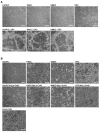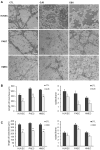Gap Junctional Interaction of Endothelial Progenitor Cells (EPC) with Endothelial Cells Induces Angiogenic Network Formation In Vitro
- PMID: 40429968
- PMCID: PMC12112054
- DOI: 10.3390/ijms26104827
Gap Junctional Interaction of Endothelial Progenitor Cells (EPC) with Endothelial Cells Induces Angiogenic Network Formation In Vitro
Abstract
Endothelial progenitor cells (EPC) are considered to support neovascularization and endothelial repair by being incorporated into newly formed or injured vessels and by improving vascularization in a paracrine manner by secreting proangiogenic factors. Here, we studied the role of gap junctional communication between EPC and endothelial cells in long-term co-cultures in vitro. The cultivation of endothelial cells together with mouse embryonic EPC (E 7.5) induced the spontaneous formation of angiogenic networks after 3-6 days consisting of both cell types, but not in the respective monocultures, whereas their respective cultivation on a basement matrix induced the formation of tube-like structures, as expected. The angiogenic network formation could not be mimicked by the incubation of endothelial cells with supernatants of EPC only. We therefore hypothesized that direct interaction and cell-cell communication is required to induce the angiogenic network formation in co-cultures with endothelial cells. Expression analysis demonstrated expression of the gap junctional protein connexin 43 (Cx43) in EPC. Moreover, dye injection studies as well as FACS analysis identified gap junctional communication between endothelial cells and EPC. The inhibition of gap junctions by pharmacological blockers significantly reduced the angiogenic network formation, confirming that gap junctional communication between both cell types is required for this process.
Keywords: angiogenesis; connexin; endothelial cells; endothelial progenitor cells; gap junction.
Conflict of interest statement
The authors declare no conflicts of interest. The funders had no role in the design of the study; in the collection, analyses, or interpretation of data; in the writing of the manuscript; or in the decision to publish the results.
Figures







Similar articles
-
VEGF promotes endothelial progenitor cell differentiation and vascular repair through connexin 43.Stem Cell Res Ther. 2017 Oct 24;8(1):237. doi: 10.1186/s13287-017-0684-1. Stem Cell Res Ther. 2017. PMID: 29065929 Free PMC article.
-
Mast Cells Interact with Endothelial Cells to Accelerate In Vitro Angiogenesis.Int J Mol Sci. 2017 Dec 13;18(12):2674. doi: 10.3390/ijms18122674. Int J Mol Sci. 2017. PMID: 29236033 Free PMC article.
-
Expression of Connexin43 Stimulates Endothelial Angiogenesis Independently of Gap Junctional Communication In Vitro.Int J Mol Sci. 2021 Jul 9;22(14):7400. doi: 10.3390/ijms22147400. Int J Mol Sci. 2021. PMID: 34299018 Free PMC article.
-
Improving vascularization of engineered bone through the generation of pro-angiogenic effects in co-culture systems.Adv Drug Deliv Rev. 2015 Nov 1;94:116-25. doi: 10.1016/j.addr.2015.03.012. Epub 2015 Mar 26. Adv Drug Deliv Rev. 2015. PMID: 25817732 Review.
-
Modulating putative endothelial progenitor cells for the treatment of endothelial dysfunction and cardiovascular complications in diabetes.Pharmacol Ther. 2017 Feb;170:98-115. doi: 10.1016/j.pharmthera.2016.10.014. Epub 2016 Oct 20. Pharmacol Ther. 2017. PMID: 27773788 Review.
References
-
- Ratliff B.B., Ghaly T., Brudnicki P., Yasuda K., Rajdev M., Bank M., Mares J., Hatzopoulos A.K., Goligorsky M.S. Endothelial Progenitors Encapsulated in Bioartificial Niches Are Insulated from Systemic Cytotoxicity and Are Angiogenesis Competent. Am. J. Physiol. Renal Physiol. 2010;299:F178–F186. doi: 10.1152/ajprenal.00102.2010. - DOI - PMC - PubMed
-
- Shin H.S., Thakore A., Tada Y., Pedroza A.J., Ikeda G., Chen I.Y., Chan D., Jaatinen K.J., Yajima S., Pfrender E.M., et al. Angiogenic Stem Cell Delivery Platform to Augment Post-Infarction Neovasculature and Reverse Ventricular Remodeling. Sci. Rep. 2022;12:17605. doi: 10.1038/s41598-022-21510-y. - DOI - PMC - PubMed
-
- Kupatt C., Horstkotte J., Vlastos G.A., Pfosser A., Lebherz C., Semisch M., Thalgott M., Buttner K., Browarzyk C., Mages J., et al. Embryonic Endothelial Progenitor Cells Expressing a Broad Range of Proangiogenic and Remodeling Factors Enhance Vascularization and Tissue Recovery in Acute and Chronic Ischemia. FASEB J. 2005;19:1576–1578. doi: 10.1096/fj.04-3282fje. - DOI - PubMed
-
- Vajkoczy P., Blum S., Lamparter M., Mailhammer R., Erber R., Engelhardt B., Vestweber D., Hatzopoulos A.K. Multistep Nature of Microvascular Recruitment of Ex Vivo-Expanded Embryonic Endothelial Progenitor Cells during Tumor Angiogenesis. J. Exp. Med. 2003;197:1755–1765. doi: 10.1084/jem.20021659. - DOI - PMC - PubMed
MeSH terms
Substances
Grants and funding
LinkOut - more resources
Full Text Sources
Miscellaneous

